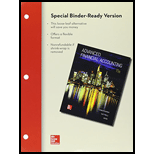
Concept explainers
a.
To compute: The book value of all the assets transferred by the parent to subsidiary.
Introduction: Internal expansion refers to situation in a company forms a subsidiary by transferring some of its assets and liabilities and in exchange of ownership shares. Shares of the subsidiary is either provided to the shareholders in addition to their existing shares (Spin off) or in exchange of their existing shares (split off).
b.
To compute: The amount that parent would report as investment in subsidiary.
Introduction: Internal expansion refers to situation in a company forms a subsidiary by transferring some of its assets and liabilities and in exchange of ownership shares. Shares of the subsidiary is either provided to the shareholders in addition to their existing shares (Spin off) or in exchange of their existing shares (split off).
c.
To compute: The number of shares that subsidiary company issued to parent.
Introduction: Internal expansion refers to situation in a company forms a subsidiary by transferring some of its assets and liabilities and in exchange of ownership shares. Shares of the subsidiary is either provided to the shareholders in addition to their existing shares (Spin off) or in exchange of their existing shares (split off).
d.
To discuss: The impact that transfer of assets and accounts payable would have on the amount reported by parent company as total assets.
Introduction: Internal expansion refers to situation in a company forms a subsidiary by transferring some of its assets and liabilities and in exchange of ownership shares. Shares of the subsidiary is either provided to the shareholders in addition to their existing shares (Spin off) or in exchange of their existing shares (split off).
e.
To explain: The effect that transfer of assets and accounts payable would have, on the amount of outstanding shares, reported by the stand alone and consolidated financial statements of parent company.
Introduction: Internal expansion refers to situation in a company forms a subsidiary by transferring some of its assets and liabilities and in exchange of ownership shares. Shares of the subsidiary is either provided to the shareholders in addition to their existing shares (Spin off) or in exchange of their existing shares (split off).
Want to see the full answer?
Check out a sample textbook solution
Chapter 1 Solutions
LOOSE-LEAF Advanced Financial Accounting with Connect
- I need help with this general accounting problem using proper accounting guidelines.arrow_forwardNeed help with this question solution general accountingarrow_forwardCompare the cost model vs. revaluation model, including pros, cons, and theoretical implications (e.g., relevance vs. reliability).arrow_forward
